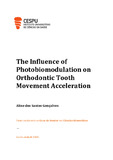The influence of Photobiomodulation on Orthodontic Tooth Movement Acceleration
Abstract
Investigating the potential and applicability of an adjunctive intervention to shorten orthodontic treatment requires, first and foremost, a deep understanding of the biological implications related to orthodontic tooth movement. Moreover, in order to understand the potential of an orthodontic motion acceleration technique, it is necessary to fully understand the current challenges and opportunities in the research of new advances in the technique, namely in the clinical efficiency of clear aligners in the production of moderate to complex movements. Given the vast list of orthodontic tooth movement acceleration techniques currently implemented, it was necessary to evaluate the different existing protocols and determine which are the most efficient. Photobiomodulation (PBM), a non-invasive and painless stimulation therapy based on the application of therapeutic radiation to target tissues, stood out among the verist techniques, given its ability to produce orthodontic acceleration rates comparable to surgical methods, without tissue damage (and associated pain and discomfort) and without the need for prolonged recovery. This evidence fostered interest in PBM and, therefore, the need to investigate the mechanism(s) of action of this therapeutic modality. To this end, an exhaustive survey of the preclinical and clinical evidence in the literature on the effectiveness of PBM in accelerating orthodontic movement was conducted. Based on this review, although it was possible to confirm the enormous potential of PBM not only to accelerate periodontal tissue remodeling, but also to reduce pain and discomfort associated with orthodontic movement, it was possible to note that there are still inconsistent results and mechanisms of action to explore. In line with these conclusions, a co-authored case study was carried out describing a 44-year-old clinical case, in which a phase of orthodontic treatment was performed with and without the use of an adjuvant method of acceleration of orthodontic tooth movement - the OrthoPulse. This study demonstrated that the PBM protocol applied was ineffective in modulating the inflammatory response and pain indices reported by the patient. This evidence, together with the review on the use of PBM as an adjuvant therapy to accelerate orthodontic movement, reinforced the thesis that PBM protocols are still suboptimal. Based on this evidence, it has become clear that PBM protocols need to be reconsidered and revised. To this end, the most effective PBM parameters to stimulate periodontal cells involved in orthodontic tooth movement were investigated, combining basic investigation with osteoblasts and fibroblasts of the periodontal ligament, multiple bioassays (e.g., expression of key proteins) and selective optimization processes. With this study, the optimal parameters of PBM were established to promote osteogenic responses and stimulate bone formation on the tension side, and to induce osteoclastogenesis and thus bone resorption, on the compression side. Thus, based on a solid bibliographic foundation on the state of the art of the use of PBM to accelerate orthodontic movement, the main objective of this thesis was to fill the knowledge gap about the most effective FBM protocols for stimulate tissue remodeling. We believe this knowledge will pave the way for the success of PBM to stimulate bone and soft tissue remodeling and to accelerate orthodontic tooth movement in future research in animal models so that its efficacy in clinical practice can be ensured.

